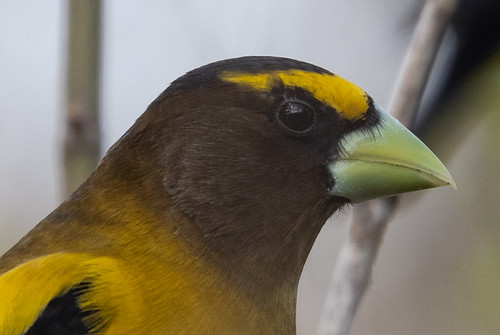On May 15, John Myers wrote a front-page article in the Duluth News-Tribune about the feast of Evening Grosbeaks that had been visiting my yard since April. John interviewed me a few days earlier, and my talking about it for a newspaper article turned into the Kiss of Death—after the interview, my flock immediately dwindled from 75 or more to just 40, and the day the article came out, it dropped to 30; the next day it was only 15. On the 18th, I had two males and two females, but then didn’t see or hear a single one on the 19th or 20th. I figured they were gone for good, but then saw a couple on the 21st and 22nd. The article was headlined, "An irruption of grosbeaks comes to Duluth, but will they stay?" The answer was apparently "no."
A few days before the numbers dropped, I’d noticed that the grosbeaks were being less cooperative in the feeders. In April and early May, I’d seen as many as 13 in a small window feeder. Sure, some of them were less tolerant than others of birds invading their personal space, but overall, they were working well as cohesive flocks.
 |
| The most I got a photo of in this window feeder is 12, but a couple of times I saw 13 in it. |
Now more and more individuals were defending more personal space, striking at others sitting within reach, and the most I was seeing in that same feeder was 2 or 3. By that time, the grosbeaks seemed to be spending far more time in the trees than at the feeders. I observed them eating buds in our maple and boxelder trees.
Many birds spend part of their lives, especially during fall migration and winter, as flocking, social species and part, during the breeding season, as territorial pairs keeping everyone else at bay. This is pretty much the progression American Robins make as they transition from their winter flocks to territorial birds. One day you’re seeing a big flock pigging out peacefully in a crabapple during a spring blizzard, and the next day, the robins are not just squabbling but outright attacking each other. That’s when flocks break up and males start claiming a territory.
Although few Evening Grosbeak pairs have been observed during the breeding season, the consensus is that they’re far less territorial than robins. One 1947 study reported at least ten nesting pairs in a loose colony in Ontario, and a 1968 study indicated that the grosbeaks tolerate other Evening Grosbeaks in their nesting tree, something American Robins would never, ever be able to deal with.
I only saw anything close to courtship behavior one day during the time my Evening Grosbeaks were here, and that was still in April, when one male fed a female, and a moment later a second male approached that same female in what appeared to be a courtship dance, his tail and bill raised and wings lowered as he sidled toward her on a branch. His pose reminded me of the courting dance of male Purple Finches. There were too many branches in the way to get a photo.
 |
| This adult male is between a young male (left) and a young female (right). This photo was taken on August 13, 2011. |
There are no records of Evening Grosbeaks nesting in Duluth, though that certainly doesn't mean they haven't. Their nests can be hard to find, and people tend to pay most attention to the birds in their feeders rather than up in the trees. But Evening Grosbeaks had to be nesting close to town in the 80s and early 90s because I frequently saw adults feeding fledglings in summer and early fall.
On August 4, 2011, a small flock comprised of family groups of Evening Grosbeaks turned up in my yard, the young birds still begging from their parents. The group stuck around so that I could see them every single day for over a month. I don’t know where they came from, but they couldn’t have nested too terribly far away. So I’m hopeful that some Evening Grosbeaks might nest not too far away this year, and that some of the adults will remember my boxelders and come back with their young when the seeds are ripe. Of course, even if some families do show up this summer for the first time in a decade, I won’t have any way of being certain that they are the same birds that visited this spring. But one thing’s for sure—if any do turn up, I won’t be talking about them to the Duluth News-Tribune, which apparently is all it takes to send them on their way.


